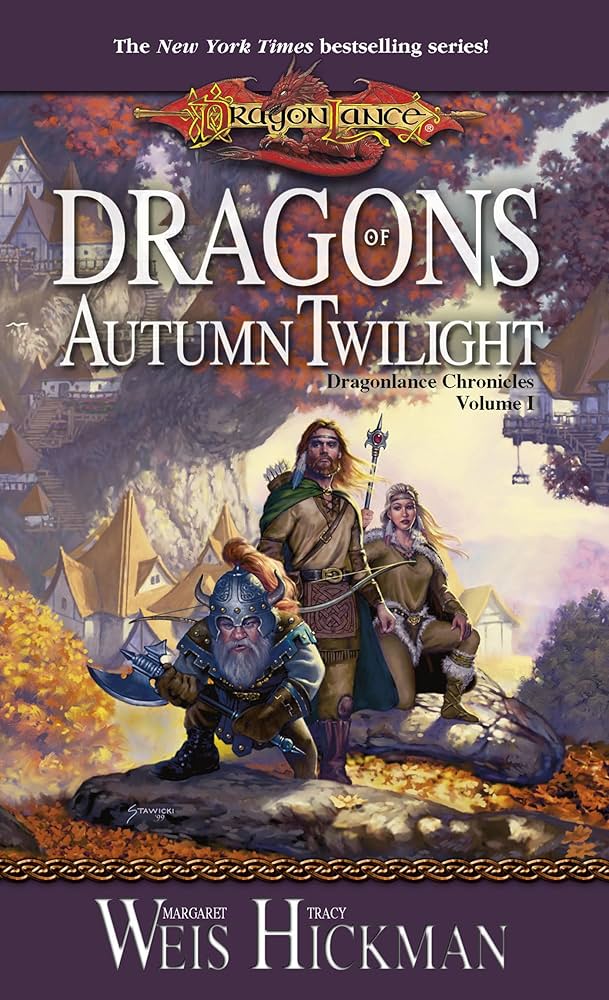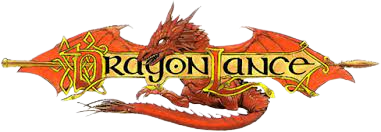Dragons of Autumn Twilight

Table of Contents
ToggleOverview
Dragons of Autumn Twilight is the first novel in the Dragonlance Chronicles, introducing readers to a sweeping tale of friendship, prophecy, war, and the return of ancient evils. Originally published in 1984, it laid the groundwork for the entire Dragonlance universe, blending the tropes of classic Dungeons & Dragons adventuring with deeply emotional character arcs and high fantasy themes.
It tells the story of a group of childhood friends—now estranged—who reunite and are thrust into a battle to save the world of Krynn from the rising evil of the Dragonarmies of Takhisis, the goddess of darkness.
Main Characters (The Companions)
Tanis Half-Elven – The conflicted and reluctant leader. Torn between two worlds (human and elven), he often questions his right to lead.
Sturm Brightblade – A proud Solamnic knight with an unshakeable moral code and sense of honor.
Caramon Majere – A strong, kind-hearted warrior and the loyal twin brother of Raistlin. Protective, but not always perceptive.
Raistlin Majere – A sickly but brilliant mage with golden skin and hourglass eyes. Ambitious, mysterious, and morally ambiguous.
Tasslehoff Burrfoot – A curious, fearless kender. Comic relief, but surprisingly insightful and brave.
Flint Fireforge – A gruff dwarven metalsmith. The “grumpy uncle” of the group, often exasperated by Tas.
Goldmoon – A noblewoman from the plains who holds the Blue Crystal Staff, a symbol of the return of true divine magic.
Riverwind – A stoic plainsman warrior and Goldmoon’s companion. Loyal and honorable.
Plot Summary
Prologue & Setting the Stage
The story opens in the wake of a shattered world. The gods have withdrawn from Krynn, and no one has heard their prayers in centuries. The world is plagued by war, corruption, and the rise of rumors about dragons, which many believe are just legends.
Five companions reunite in the town of Solace after years apart, each carrying their own burdens. They’ve agreed to meet and share news about their individual searches for signs of the true gods.
Things go awry immediately.
The Blue Crystal Staff
The group encounters Goldmoon and Riverwind, fleeing from persecution because of a mysterious healing staff. When the staff is used to heal an injured man, they are targeted by the authorities, leading to a dramatic escape and a forest fire.
This staff becomes the first sign that the gods of Good have returned, marking Goldmoon as a chosen prophet of Mishakal, the goddess of healing.
Journey to Xak Tsaroth
The group journeys to the ancient, ruined city of Xak Tsaroth, where they encounter:
- Draconians – twisted dragon-like foot soldiers created from corrupted dragon eggs
- The black dragon Khisanth – a terrifying guardian of the city
There, Goldmoon receives the first Disc of Mishakal, and becomes the first true cleric of Good in centuries.
War and Resistance
As they travel, the group learns of the growing strength of the Dragonarmies, led by Highlord Verminaard, who serves the evil goddess Takhisis. Villages fall, innocents are enslaved, and the old orders (like the Knights of Solamnia) have grown weak and distrusted.
They join up with a growing resistance movement, meet new allies, and become entwined in a larger conflict. Along the way, they visit dwarves in Thorbardin, confront corruption in the elven homeland Qualinesti, and witness the horrifying scale of the enemy’s power.
The Battle for Pax Tharkas
The story culminates in a daring assault on Pax Tharkas, a fortress where Verminaard holds hundreds of slaves. The companions lead a prisoner revolt and face off against Verminaard himself, who wields divine magic granted by Takhisis and commands the red dragon Ember.
The group emerges victorious, but at great cost. The world is now fully aware: the dragons have returned, and war has truly begun.
Major Themes
- Faith Rediscovered – The gods may be silent, but belief is not dead. Goldmoon’s discovery of divine magic is a turning point for the world.
- The Burden of Leadership – Tanis must navigate personal doubts, love triangles, and group dynamics while trying to save the world.
- Moral Ambiguity – Raistlin’s dark path, Tanis’s indecision, and the fractured trust in institutions all reflect the uncertainty of a post-Cataclysm world.
- Unity vs. Division – The companions’ strength lies in their diversity, even as tensions threaten to pull them apart.
- The Rise of Evil – The story showcases the organized threat of the Dragonarmies, not as mindless monsters, but as a religious and political crusade.
Tone & Style
Dragons of Autumn Twilight reads like a classic Dungeons & Dragons campaign novelized—because it was. The structure follows:
- Dungeon crawls (Xak Tsaroth)
- Party conflicts (Tanis/Raistlin, Tanis/Flint)
- Strategic battles and set-piece encounters
- Romantic subplots
- Worldbuilding through travel and NPC interactions
The tone balances lighthearted character banter (especially from Tas and Flint) with serious war themes and moral tension.
Reception
Dragons of Autumn Twilight is beloved as a foundational work in fantasy gaming literature, though it has received mixed critical reviews over the years:
Praise:
- Memorable ensemble cast
- Accessible, fast-paced storytelling
- Great entry point to the Dragonlance world
- Captures the feeling of a tabletop RPG adventure
Criticism:
- Pacing can be uneven
- Some character arcs are clearly setup for later payoff (especially Raistlin)
- Derivative in places—but intentionally so, as it helped establish fantasy archetypes
Final Thoughts
Dragons of Autumn Twilight is a legendary starting point—a tale of rediscovered gods, reunited friends, and rising darkness. It blends old-school fantasy adventure with new emotional complexity, setting the stage for the epic to follow.
It’s essential reading for:
- Dragonlance newcomers and RPG-inspired fantasy fans
- Readers who enjoy ensemble casts and world-spanning quests
- Anyone who wants to see where Raistlin, Tanis, and the War of the Lance began
